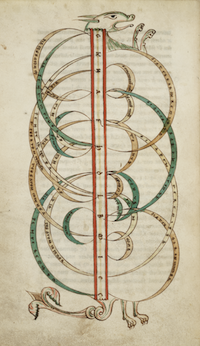How-To

Zoomorphic diagram from Boethius’ De Institutione Musica *
This page is intended to give old and new users an overview of the possible ways to use the TML website.
Browsing
The content of the TML can be perused by browsing several indices and lists [menu: ‘About’]. Historically, the TML website provided indices by century to discover the content, which listed authors, titles and sources of each text (file), with a link on the filename taking the user to the relevant content. From the 2017 edition, these indices feature a default compact view of author+title, which may be expanded to show more information on demand (through ‘+’ buttons and an ‘Action’ panel, features present throughout the site). For more expedient browsing, these indices can be also reordered by title or filename, or filtered by kind of source (editions or manuscript transcriptions).
The 2017 edition provides also lists of authors, titles, and incipits of all texts independent of their dating. The list of authors features a basket-like utility to select multiple authors (or different spellings of the same), and authorities from the Lexicon musicum Latinum may be added to the list.
Texts may be also accessed by browsing a list of the sources from which the texts are taken. This list is also useful to see which editions and manuscripts are effectively searched through the search utility (matches will be found in texts from this list only!). A complementary list of editions that are planned for future inclusion is available in the content page [menu: ‘About ˃ Content’]. Last but not least, the list of contributors recognizes the work of the many scholars who over the years have helped in the making of the TML corpus.
In the extras section, it is also possible to browse concordances established between the TML and two external resources relevant to the field. This information may be helpful to discover the TML content starting from canonical attributions and titles, since the TML internal metadata reflects what is given in the individual sources.
Searching
If the user is looking for a specific text or phrase or wants to discover all the instances of a particular term, the search page is recommended. The first things to consider when searching is that 1) the TML reproduces texts exactly as in the sources, so it is always advisable to try alternative spellings; and 2) the search utility finds words and phrases in the text of the treatises, not in the metadata. Please read about all the rules for searching (in the 2017 edition they have changed), and follow the hints given there. Simple queries based on the same rules (without the filtering options offered in the main search page) can be submitted in the ‘Quick search’ boxes throughout the site.
Reading
The principle aim of the TML is to make available the full text and any accompanying figures (graphics) of the treatises. Note that texts are reproduced exactly as in the sources, including any typos. Only the edited or main text is given: no introductions, footnotes or apparatus are included. Long texts may be split into multiple parts. Square brackets in grey show the page numbers in the original source.
In the reading view, basic metadata are shown. If a text is reproduced by permission, a notice is displayed. If the page was reached through a search, the searched terms remain highlighted by default.
Up to three buttons can be present. When shown, the image gallery button opens and cycles through the images accompanying the text (music examples and other figures). These can be also opened from direct links where they occur in the text. The tml notes button makes available various notes on the text. The concordances button shows the concordances found between the text and other resources. When concordances with the Lexicon musicum Latinum are found, the system may also have information to display about the manuscript sources (of the canonical texts), from the Répertoire international des sources musicales.
